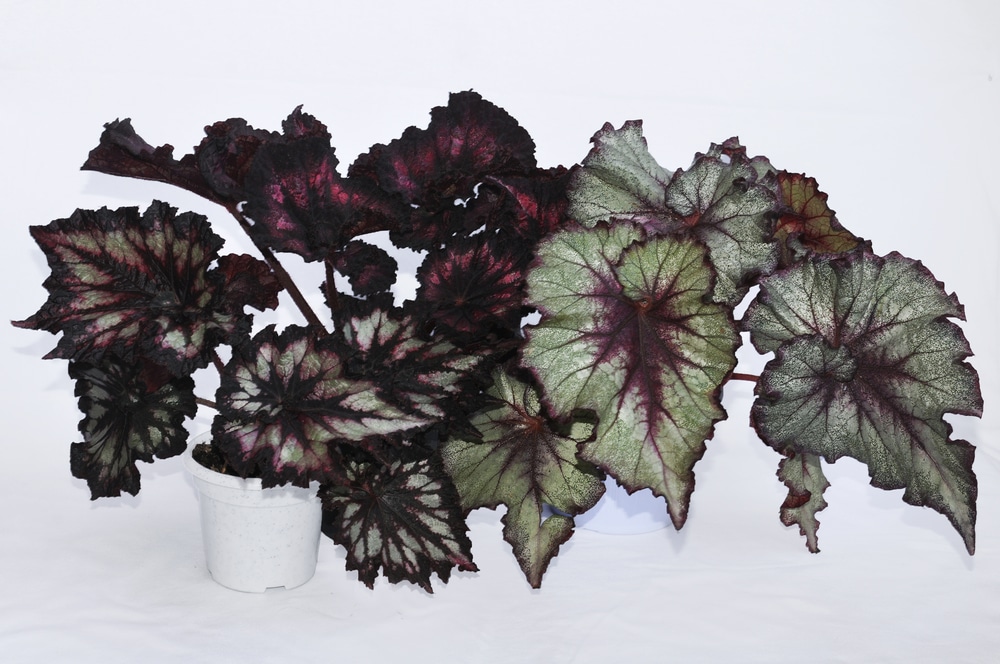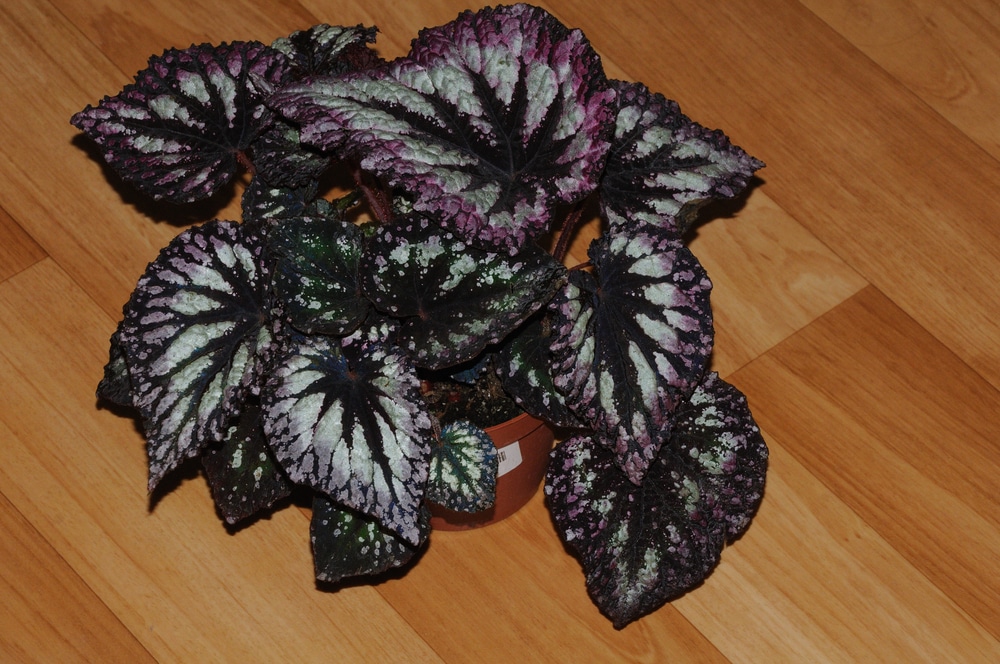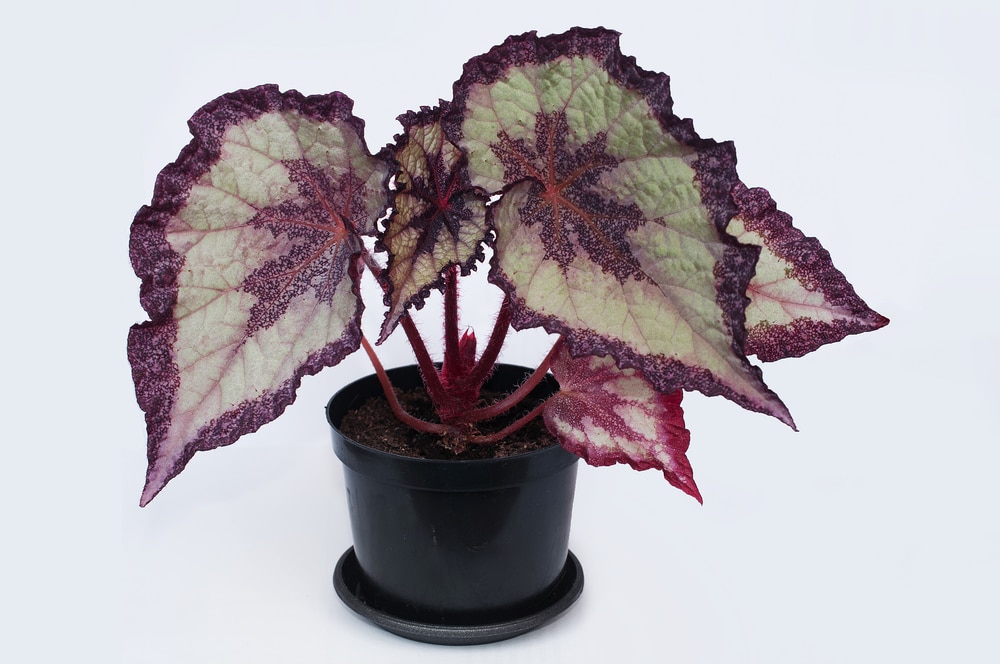You don’t earn the nickname The King without having an awe-inspiring display. Even among begonia aficionados, Begonia Rex foliage is considered magnificent. The Rex Begonia, or Begonia Rex, even lives up to its royal status by being a bit fussy when it comes to care. It’s only what one would expect from royalty!
Begonia Rex is also commonly known as Painted-Leaf Begonia and Fancy-Leaf Begonia.
Rex Begonia Origin and History
The king begonia is originally from southeast China and northwestern India. In 1856, a batch of orchids shipped from India to England carried an unplanned guest – a striking plant with fascinating leaf patterns. This was the Begonia Rex.
Begonia Rex wasn’t the first begonia to find its way to Europe – the first documented begonia is from Brazil and was described in 1690 by a Franciscan monk. However, the accidental tag-a-long in the orchid shipment was the first Begonia Rex to be documented.
This first king begonia featured dark green scalloped leaves with thick grayish-silver bands. It quickly became popular in the plant world, and hybrids happened soon after since Rex Begonia crosses with other begonias easily. Now, there are over 500 cultivars of this one plant. And it all began with one serendipitous orchid shipment 150 years ago.
Because there are so many fascinating and really spectacular hybridized versions of Begonia Rex, it is impossible to give a thorough detailing of all the color and foliage options. The most well-known versions feature dark emerald green leaves with frilly or scalloped edges and magenta and light pink swirls or bands.
The foliage patterns are brilliant – there are hearts, swirls, bands, seashell spirals, ivy leaves, polka dots, splashes, stripes, and camouflage. In addition to the exotic patterning, the colors are always bold – deep burgundies, emerald greens, light pinks, and metallic grayish-silvers. If a plant could swagger, Rex Begonia would be the one.

Rex Begonia Care
In this section we cover important Rex Begonia care topics such as water, lighting, fertilizing, re-potting, and more.
Growth Habit
The growth habit varies with the cultivars, but they are generally on the small side. Most don’t grow more than a foot and a half tall. They will spread out just as wide as they are tall. Begonia Rex leaves grow singularly atop slender stems. The leaves grow up to 12 inches long and 8 inches wide – they are massive compared to the plant’s overall height.
Rex begonia leaves are lightly hairy with very prominent veins. The underside of the leaves is red, another attractive feature of this houseplant.
Light
The king begonia likes moderate to high amounts of bright, indirect sunlight. Do not put it in direct light, or the foliage will burn. It’s best to set the plant a foot or more away from a window or use a sheer curtain to block the harshest rays from the sun.
If you notice the stems stretching or getting leggy, it means the plant is extending itself to reach more light. On the other hand, if the leaves are turning brown and crispy, it is getting too much direct light. Turn the plant every couple of weeks to encourage even growth on all sides.
Watering
Even watering is the best. Begonia Rex doesn’t like being overwatered, and it hates drying out. So, it is essential to pay attention to ensure the watering is consistent and thorough. There is no set timing for watering as so much depends on the climate conditions in your home. Check it regularly until you get a feel for what your begonia needs.
The best test is to stick your finger in the soil to assess the moisture. The top one inch of soil should be dry before watering. If it is still moist, wait a few more days. It’s best to err on the side of underwatering – the soil should be mostly dry but not parched before each watering. Water heavily when it’s time, but don’t water too often.
Begonia Rex is sensitive to tap water with lots of minerals and salt. These elements cause the edges of the leaves to burn. The king begonia moves the salts and minerals to the leaf edges in a valiant attempt to remove them from their system. If you have hard tap water high in minerals and salt, only water with distilled water.
Temperature & Humidity
Begonia Rex is temperamental about temperature and humidity. It does okay with standard home temperatures between 65F-75F but will suffer in room temperatures below 60F. It definitely prefers climates on the warmer side.
Be very careful about keeping your Begonia Rex away from cold drafts, heaters, wood stoves, and air conditioners. The foliage is extremely sensitive and susceptible to temperature swings.
The king begonia does not tolerate low humidity. This is the biggest hurdle home-growers face. Humidity levels must be above 50% for the begonia to thrive.
Misting and DIY pebble trays rarely provide adequate moisture boosts – with this houseplant, you will probably need to invest in a small humidifier. And, a humidifier can support many plants, so you might as well get a bunch more of the showy king begonias!
Soil and Potting
A high-quality potting soil mix works great for the king begonia. Add in a couple of handfuls of coco coir and perlite to increase the aeration and draining capabilities. These additions improve the soil and reduce the chances of soggy soil and root rot.
Always use a pot with drainage holes so water can drain through properly. A shallow, wide pot is best, so the rhizomes (root system) can spread out easily.
Fertilizer
Apply a balanced houseplant fertilizer every 2-3 weeks during the growing season. Don’t add fertilizer in the winter when the begonia is resting.
Pruning
Pruning isn’t necessary except to remove dead or dying leaves. A leggy king begonia can be pruned to create a bushier, fuller look.
Repotting
This begonia likes being a bit rootbound, so don’t worry about moving it to a larger pot unless you want the plant to grow bigger. Repot every year, though, to replace and refresh the potting soil. The nutrients in potting soil get used up and need replenishing.
Repot the king begonia in spring, at the beginning of the growing season. Always choose a pot with drainage holes. If you’re going to repot to a larger container size, pick one that is just one size larger.
Toxicity
King begonia is slightly toxic to cats, dogs, and humans. Keep it away from small children and pets.
Winter Dormancy
Most Begonia Rex cultivars will enter a period of dormancy in winter. You should hold off on watering during this time and don’t add any fertilizer. The houseplant will stop growing and may drop some or all of its foliage. Let it rest, and it’ll spring back in spring.

Begonia Rex Propagation
Only take cuttings from mature, healthy plants.
Water Stem Propagation
- Sterilize a pair of scissors.
- Cut a young leaf with a strong stem.
- Place the cutting into a jar or vase of water – the node must be submerged.
- Put the jar in a location with bright, indirect light.
- Refill the water regularly as it gets low.
- New roots should appear in 3-6 weeks.
- Wait until the roots are several inches long, then pot up in soil.
Rhizome Propagation
- Cut a length of the rhizome (the “root”) with sterilized scissors. The rhizome should include a growth node.
- Lay the rhizome horizontally in a container with potting soil.
- Cover the rhizome halfway with the soil, so the top is still exposed.
- Water the cutting.
- Cover the container with an airtight lid or put plastic wrap tightly around it.
- Put the container in a location with bright, indirect sunlight (not the direct sun!).
- When leaves start appearing, remove the lid and water as usual.
- Once the cutting has hardened, it can be moved to a pot.
Begonia Rex Pests and Diseases
Here are a few common pests and diseases that you should look out for when keeping Rex Begonia.
Powdery Mildew
This is a common problem with Begonia Rex because of the high humidity, which then leads to fungal growth. It happens when leaves get wet and remain wet too long. To prevent it from happening, avoid getting the leaves wet. A watering can with a long spout will make this easier. Treat powdery mildew with a fungicide to kill the spores. Also, remove any affected leaves, so it doesn’t spread.
Since powdery mildew can be difficult to treat, it’s best to focus on prevention. Maintain good airflow around the plant, only water the soil, and never mist the leaves. Watering in the morning helps a lot, too, because it allows time for the leaves to dry if they do get wet.
Botrytis Blight
This is another common problem with a houseplant that likes lots of moisture. Blight looks like silver or gray spores on the foliage. If you see this, immediately move the plant away from any other, as blight loves to spread. Cut off infected leaves and dispose of them. Then, apply a fungicide. This disease is challenging to fight, so make sure you tackle it at the first signs of infection.
Mealybugs, Thrips, Whiteflies, Spider Mites, and Aphids
The key to catching these little bugs as early as possible is through frequent, systematic investigation of the plant. The other vital part is to be consistent; continue treating even after you don’t see any signs of pests. Larvae or eggs hide in the soil or leaf undersides.
Use a neem oil spray to treat these pests. Mix 2 teaspoons neem oil with one teaspoon dish soap in a quart spray bottle. Fill the rest of the bottle with water and shake well. Spray the entire plant, leaf tops and undersides, stems, and soil. Do this in the morning so the leaves have time to dry. Repeat the application of neem oil spray every 4-7 days.
Begonia Rex Common Questions
Here are a few of the most common Rex Begonia care questions that we get:
Will my Begonia Rex flower?
Most likely, no. This houseplant is grown for its stunning foliage and rarely blooms indoors. If it does produce blooms, it will happen in the winter. Rex Begonia flowers are tiny, pink or white, and relatively muted compared to the foliage.
All the leaves are falling off my Begonia Rex – what is happening?
If it is winter, this is normal and a part of dormancy. The plant may shed all its leaves during this time, or just some of them. Reduce watering and abstain from fertilizing and let the begonia have some downtime. It will come back in spring even stronger than before.
Leaf drop happening during the growing season is a sign of trouble. Overly dry air causes Begonia Rex to dry out and drop all its leaves. In this case, you’d need to increase the humidity to save the plant.
The primary way to differentiate between dormancy leaf drop and problematic leaf drop is what happens to the leaves beforehand. If the leaves slowly turn yellow and drop off, that’s a slow transition to dormancy. But, if the leaves get brown and crispy and fall off, that’s a cry for more humidity.
Is Rex Begonia difficult to care for?
They aren’t difficult, but they are particular. If you’re not prepared to spend some time nurturing a houseplant, this might not be the best choice for you. It definitely isn’t one you can ignore, especially when it comes to temperature and humidity needs.
Begonia Rex of any variety and color are a stunning addition to the household. The vibrancy of the foliage adds depth with a big splash of design. Put Begonia Rex where it can flaunt its colors, but don’t forget the humidity!

